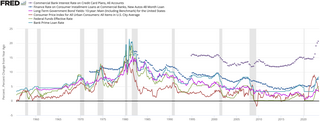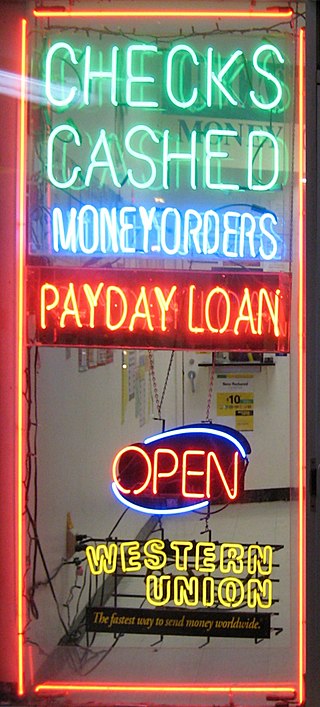Related Research Articles

In finance and economics, interest is payment from a borrower or deposit-taking financial institution to a lender or depositor of an amount above repayment of the principal sum, at a particular rate. It is distinct from a fee which the borrower may pay to the lender or some third party. It is also distinct from dividend which is paid by a company to its shareholders (owners) from its profit or reserve, but not at a particular rate decided beforehand, rather on a pro rata basis as a share in the reward gained by risk taking entrepreneurs when the revenue earned exceeds the total costs.

Debt is an obligation that requires one party, the debtor, to pay money borrowed or otherwise withheld from another party, the creditor. Debt may be owed by sovereign state or country, local government, company, or an individual. Commercial debt is generally subject to contractual terms regarding the amount and timing of repayments of principal and interest. Loans, bonds, notes, and mortgages are all types of debt. In financial accounting, debt is a type of financial transaction, as distinct from equity.

In finance, a loan is the transfer of money by one party to another with an agreement to pay it back. The recipient, or borrower, incurs a debt and is usually required to pay interest for the use of the money.
A reverse mortgage is a mortgage loan, usually secured by a residential property, that enables the borrower to access the unencumbered value of the property. The loans are typically promoted to older homeowners and typically do not require monthly mortgage payments. Borrowers are still responsible for property taxes or homeowner's insurance. Reverse mortgages allow older people to immediately access the home equity they have built up in their homes, and defer payment of the loan until they die, sell, or move out of the home. Because there are no required mortgage payments on a reverse mortgage, the interest is added to the loan balance each month. The rising loan balance can eventually grow to exceed the value of the home, particularly in times of declining home values or if the borrower continues to live in the home for many years. However, the borrower is generally not required to repay any additional loan balance in excess of the value of the home.
Revolving credit is a type of credit that does not have a fixed number of payments, in contrast to installment credit. Credit cards are an example of revolving credit used by consumers. Corporate revolving credit facilities are typically used to provide liquidity for a company's day-to-day operations. They were first introduced by the Strawbridge and Clothier Department Store.

The term annual percentage rate of charge (APR), corresponding sometimes to a nominal APR and sometimes to an effective APR (EAPR), is the interest rate for a whole year (annualized), rather than just a monthly fee/rate, as applied on a loan, mortgage loan, credit card, etc. It is a finance charge expressed as an annual rate. Those terms have formal, legal definitions in some countries or legal jurisdictions, but in the United States:
A credit history is a record of a borrower's responsible repayment of debts. A credit report is a record of the borrower's credit history from a number of sources, including banks, credit card companies, collection agencies, and governments. A borrower's credit score is the result of a mathematical algorithm applied to a credit report and other sources of information to predict future delinquency.

Second mortgages, commonly referred to as junior liens, are loans secured by a property in addition to the primary mortgage. Depending on the time at which the second mortgage is originated, the loan can be structured as either a standalone second mortgage or piggyback second mortgage. Whilst a standalone second mortgage is opened subsequent to the primary loan, those with a piggyback loan structure are originated simultaneously with the primary mortgage. With regard to the method in which funds are withdrawn, second mortgages can be arranged as home equity loans or home equity lines of credit. Home equity loans are granted for the full amount at the time of loan origination in contrast to home equity lines of credit which permit the homeowner access to a predetermined amount which is repaid during the repayment period.

Credit is the trust which allows one party to provide money or resources to another party wherein the second party does not reimburse the first party immediately, but promises either to repay or return those resources at a later date. The resources provided by the first party can be either property, fulfillment of promises, or performances. In other words, credit is a method of making reciprocity formal, legally enforceable, and extensible to a large group of unrelated people.
This article gives descriptions of mortgage terminology in the United Kingdom.
Payment protection insurance (PPI), also known as credit insurance, credit protection insurance, or loan repayment insurance, is an insurance product that enables consumers to ensure repayment of credit if the borrower dies, becomes ill or disabled, loses a job, or faces other circumstances that may prevent them from earning income to service the debt. It is not to be confused with income protection insurance, which is not specific to a debt but covers any income. PPI was widely sold by banks and other credit providers as an add-on to the loan or overdraft product.
A land contract,, is a contract between the buyer and seller of real property in which the seller provides the buyer financing in the purchase, and the buyer repays the resulting loan in installments. Under a land contract, the seller retains the legal title to the property but permits the buyer to take possession of it for most purposes other than that of legal ownership. The sale price is typically paid in periodic installments, often with a balloon payment at the end to make the timelength of payments shorter than in the corresponding fully amortized loan. When the full purchase price has been paid including any interest, the seller is obligated to convey legal title to the property. An initial down payment from the buyer to the seller is usually also required.
In banking and finance, an amortizing loan is a loan where the principal of the loan is paid down over the life of the loan according to an amortization schedule, typically through equal payments.

A mortgage loan or simply mortgage, in civil law jurisdictions known also as a hypothec loan, is a loan used either by purchasers of real property to raise funds to buy real estate, or by existing property owners to raise funds for any purpose while putting a lien on the property being mortgaged. The loan is "secured" on the borrower's property through a process known as mortgage origination. This means that a legal mechanism is put into place which allows the lender to take possession and sell the secured property to pay off the loan in the event the borrower defaults on the loan or otherwise fails to abide by its terms. The word mortgage is derived from a Law French term used in Britain in the Middle Ages meaning "death pledge" and refers to the pledge ending (dying) when either the obligation is fulfilled or the property is taken through foreclosure. A mortgage can also be described as "a borrower giving consideration in the form of a collateral for a benefit (loan)".
Seller financing is a loan provided by the seller of a property or business to the purchaser. When used in the context of residential real estate, it is also called "bond-for-title" or "owner financing." Usually, the purchaser will make some sort of down payment to the seller, and then make installment payments over a specified time, at an agreed-upon interest rate, until the loan is fully repaid. In layman's terms, this is when the seller in a transaction offers the buyer a loan rather than the buyer obtaining one from a bank. To a seller, this is an investment in which the return is guaranteed only by the buyer's credit-worthiness or ability and motivation to pay the mortgage. For a buyer it is often beneficial, because he/she may not be able to obtain a loan from a bank. In general, the loan is secured by the property being sold. In the event that the buyer defaults, the property is repossessed or foreclosed on exactly as it would be by a bank.

Car finance refers to the various financial products which allow someone to acquire a car, including car loans and leases.
The credit channel mechanism of monetary policy describes the theory that a central bank's policy changes affect the amount of credit that banks issue to firms and consumers for purchases, which in turn affects the real economy.

A payday loan is a small, short-term unsecured loan, "regardless of whether repayment of loans is linked to a borrower's payday." The loans are also sometimes referred to as "cash advances," though that term can also refer to cash provided against a prearranged line of credit such as a credit card. Payday advance loans rely on the consumer having previous payroll and employment records. Legislation regarding payday loans varies widely between different countries and, within the United States, between different states.
source of business financing refers to the means by which an aspiring or current business owner obtains money to start a new small business, purchase an existing small business or bring money into an existing small business to finance current or future business activity. There are many ways to finance a new or existing business, each of which features its own benefits and limitations. In the wake of the financial crisis of 2007–08, the availability of traditional types of small business financing dramatically decreased. At the same time, alternative types of small business financing have emerged. In this context, it is instructive to divide the types of small business financing into the two broad categories of traditional and alternative small business financing options.
Buy now, pay later (BNPL) is a type of short-term financing that allows consumers to make purchases and pay for them at a future date. BNPL is generally structured like an installment plan money lending process that involves consumers, financiers, and merchants. Financiers pay merchants on behalf of the consumers when goods or services are purchased by the latter. These payments are later repaid by the consumers over time in equal installments. The number of installments and repayment period varies depending on the BNPL financiers.
References
- ↑ "Loans". Entrepreneur Media. Retrieved 10 March 2015.
- ↑ Limitations on Terms of Consumer Credit Extended to Service Members and Dependents; Final Rule
- ↑ Rhode, Steve (December 3, 2009). "The History of Credit & Debt – Early Installment Sales". GetOutOfDebt.org.